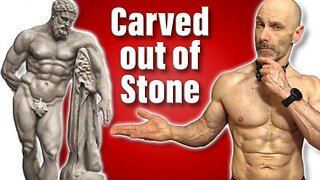The Safest Squat (Best for Back and Knees)
Today we’re going to compare a few basic variations of the squat to see which is the easiest and safest to do and how we can progress these to the point where we can do a full back squat.
I hear people tell me that they can’t squat, but if you can sit in a chair or on the toilet, then you can squat.
The two areas most commonly cited as reasons not to squat are the knees and low back. One more spot of potential concern is the shoulders, as some lack the mobility to reach back and hold the bar without pain when doing a back squat.
The first two squat variations we’ll look at are the low dumbbell sumo squat and a bench or box squat.
Remember I said if you can sit in a chair, you can do a squat, while essentially, doing a bench squat is just that sitting on a bench or a box.
There are a couple of things to keep in mind when doing bench squats. Taking a wider stance gives you a more vertical shin reducing the stress on the knee. Sitting back on the bench reduces it even more.
When you do this, your hips go back, and you bend deeper at the waist, boosting hip activation and increasing glute and hamstring involvement in addition to the quads making this a more whole-leg exercise.
When you squat like this, you won’t be able to use as much weight as when doing a suitcase or back squat. I recommend dumbbells for this exercise over a barbell as it’s easier to stabilize a weight down low, taking some of the stress off the low back.
Because you’re sitting on a bench, it gives you a defined stopping point and ensures you’re going deep enough on every rep. You pause at the bottom, so there’s no bounce and continue to keep your core braced throughout the movement. An additional bonus is it helps to develop more power out of the bottom of a squat.
Next up is the low dumbbell sumo squat. Having the dumbbell down low makes for an easy setup, as you don’t have to get it into the goblet position, which can be somewhat awkward. The dumbbell provides a stopper keeping you from going too low. Mind you, as you get stronger and start to use a heavier dumbbell, it will reduce your range of motion.
Because the sumo stance is wide, again, this reduces the stress on the knees and increases adductor, abductor and glute involvement.
Next up is the suitcase squat. The body mechanics are much like a trap bar deadlift with a little less hip flexion when compared to a traditional deadlift.
I place the dumbbells on a bench and start in the standing position. This allows me to control the depth of my squat based on my body mechanics. Protecting my back and ensuring I don’t compromise my posture while picking up the dumbbells from the floor at the beginning of each set.
Before we move to an exercise that requires more core stabilization, I want to mention a piece of equipment I tried out when I was at Bells of Steel, and that’s their belt squat machine. It provides all the benefits of a squat without the stress on your back because the load is on the hips and not the upper back.
So if you have one of these in your gym, you should give it a try or consider making it an addition to your home gym.
Because the weight is in front on a goblet squat, it puts you in a more upright position taking stress off the back. But it’ll require more core stability than either a suitcase or low dumbbell sumo squat. In addition, you may find you get a greater range of motion and might have to lighten up the weight until you gain strength in this new range.
Another advantage of a goblet squat over a back squat is holding the weight in front is more shoulder-friendly than having a straight bar on your back. There’s what’s called a safety bar which allows you to back squat while keeping your shoulders in a comfortable position with your hands in front.
Getting the weight into the goblet position can become challenging as the weight gets heavier. The heaviest dumbbell I own is 100 lbs, and I get it into place by standing it on a bench and then squatting down to pick it up. If I want to use more than 100 lbs, I’ll use 2 dumbbells and clean them into place. This becomes a dumbbell front squat with all the same advantages as a goblet squat.
As you gain strength, you may want to elevate your heels to increase the range of motion, making it more challenging without increasing weight.
I want to bring up split squats. Because of the balance component, I wouldn’t list them as the easiest squat, but by the time we are at this level, we’re well past the easiest squats.
Split squats allow us to train each leg unilaterally for even development and cut the weight we need to use in half.
-
 4:47
4:47
Fit and 50
8 months ago $0.03 earnedThe Best Way to Choose Exercises for Muscle Growth (Greek god Physique)
4052 -
 5:49:05
5:49:05
Akademiks
21 hours agoDrake Next Move - Whats next?? Did Lil Baby Listen to Me? Diddy and Family Preparing for Indictment?
62.6K53 -
 1:56:06
1:56:06
TimcastIRL
1 day agoTrump Raises RECORD $52.8 MILLION In One Day, Bonus Uncensored Show w/Laura Loomer | Timcast IRL
88.2K391 -
 23:19
23:19
Scammer Payback
4 days agoWe Created the First Ever 𝗔𝗡𝗧𝗜-𝗦𝗖𝗔𝗠 Call Center
212K247 -
 1:11:09
1:11:09
LFA TV
22 hours agoTRUMP GUILTY…OF LOVING AMERICA! Ft. Hayley Caronia & Vish Burra | LAST CALL 6.1.24 8PM EST
73.9K32 -
 1:02:02
1:02:02
The Kirk Minihane Show
14 hours ago420 Show
51.6K2 -
 1:06:35
1:06:35
Patriots With Grit
13 hours agoSpeaking Up, Pushing Back | Daniel McGirr
46.4K7 -
 56:19
56:19
Total Horse Channel
2 days ago2024 Buckeye Reining Series | Saturday Night | 7:30 pm EST
54.7K5 -
 1:15:38
1:15:38
Steve-O's Wild Ride! Podcast
2 days ago $0.22 earnedG Eazy Opens Up About Falling Off - Wild Ride #217
61.8K14 -
 18:44
18:44
We Profit with Stock Curry
6 days agoUltimate Advice for Teens & Young Adults
68.4K17